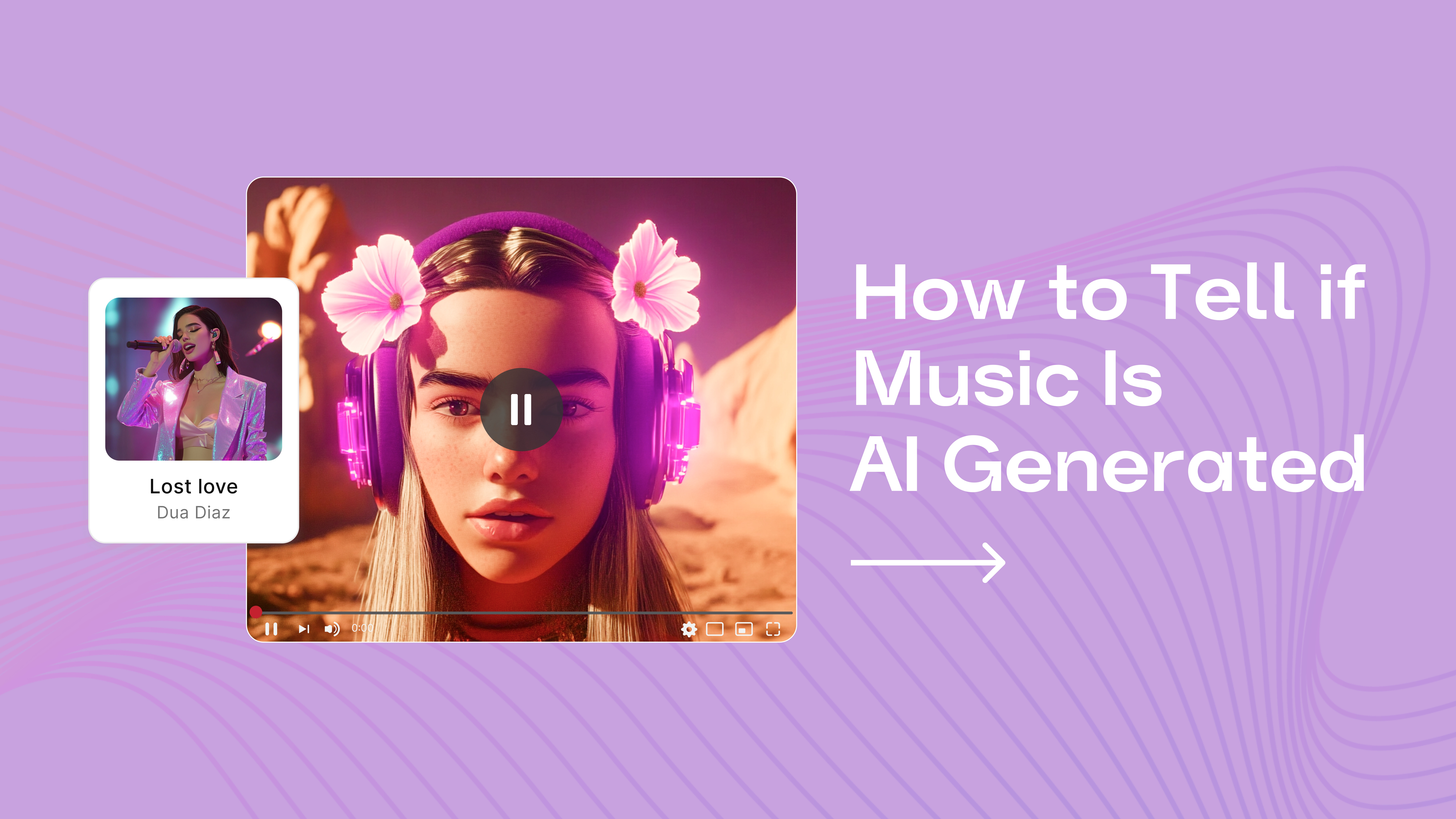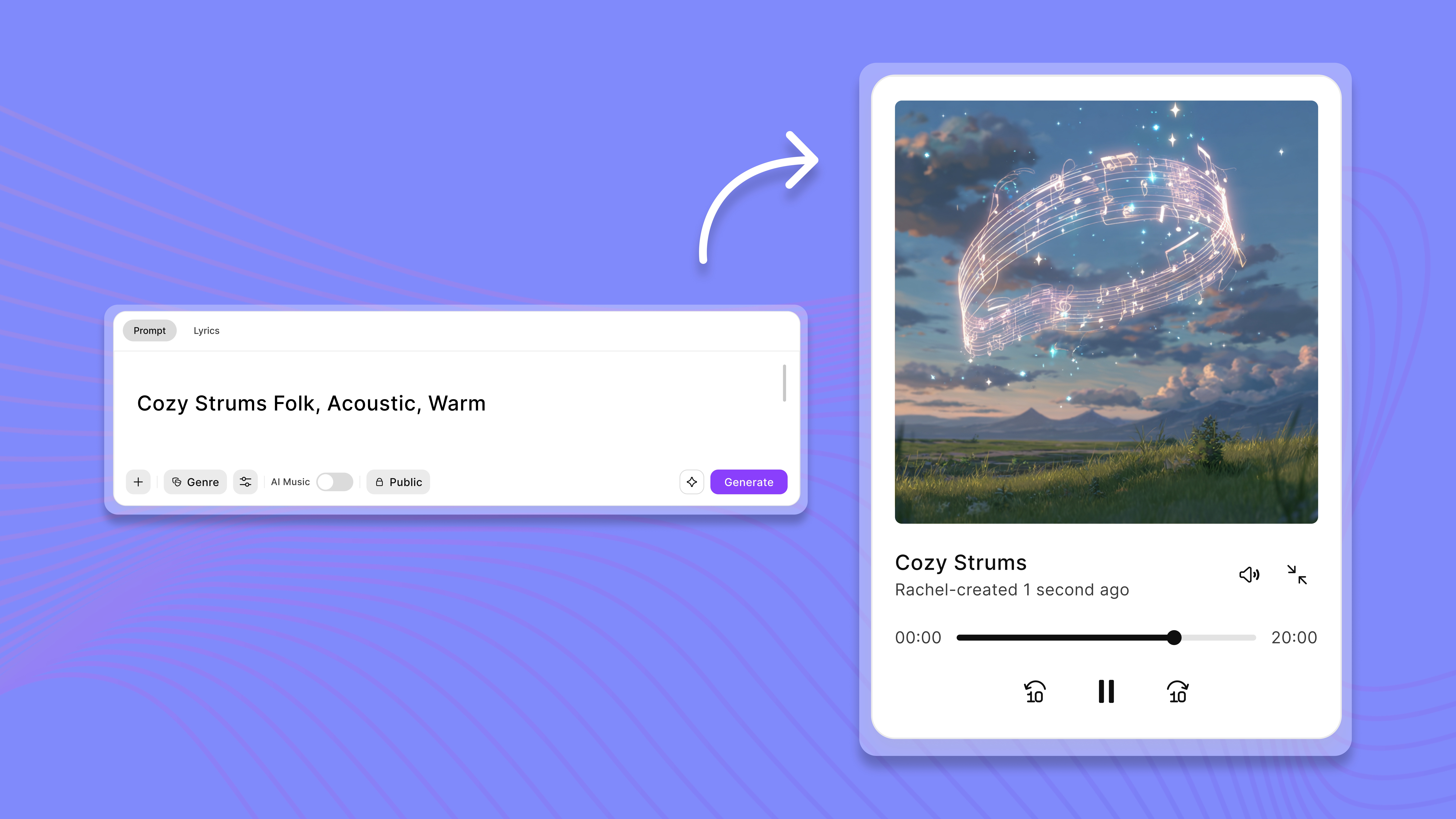

Areeba Imran
Thu Jul 24 2025
6 mins Read
How to Tell if Music Is AI Generated: A Simple Guide for Creators and Listeners
 feature image.jpg
feature image.jpg
Let’s be honest: AI music is everywhere now. Some of it sounds like it came straight out of a sci-fi film. Some of it? Weirdly good. Let's not forget how many AI Music Generators have completely taken over. So good, in fact, that you might find yourself wondering, did a person actually make this?
If you're a content creator, musician, or even just someone with a halfway decent ear for tunes, figuring out whether a song was generated by AI can be a useful skill. And no, you don’t need to be a sound engineer to pull it off.
This guide breaks it down simply, just ten things to check. No fluff. No jargon. Let’s dive in.
Why Knowing Matters: Real Use Cases
 Why Knowing Matters.jpg
Why Knowing Matters.jpg
1. Copyright Clarity for Content Creators:
When you're working on a YouTube video, a podcast, or a personal project, using music you can’t verify might get you in trouble. Knowing whether the track is AI-generated gives you a better idea of whether it's royalty-free or if someone owns the rights.
2. Protecting the Craft for Musicians:
Artists want to stand out, not sound like a machine. Understanding AI-generated music helps musicians make sure their work doesn’t accidentally mimic the algorithmic stuff flooding streaming platforms.
3. Quality Control for Marketers and Brands:
Let’s say you're launching a product and want the background music to connect emotionally. You don’t want generic sounds made by a robot. Being able to spot AI music can help you pick something more original and human.
4. Research for Students and Developers:
If you're learning about AI or studying music production, knowing the difference between AI and human music helps you understand how far tech has come and where it still lags.
5. Screening Submissions for Platforms:
Music platforms and submission-based services might want to detect whether a piece was made by a person or generated, especially when originality is part of the criteria.
6. Educators in Music Theory:
Teachers can use AI-generated songs to show students examples of repetition, lack of dynamics, and structural rigidity in contrast to more emotionally developed human pieces.
7. Playlist Purists and Audiophiles:
Some listeners just want that raw, imperfect human touch. If you’re putting together a jazz playlist, you probably don’t want tracks that sound like they were made by an algorithm trained on 10,000 royalty-free loops.
8. Legal and Licensing Professionals:
Entertainment lawyers or music licensing experts may need to verify the origin of a track for copyright claims, disputes, or licensing agreements.
Step by Step Guide: How To Tell If Music Is AI Generated
Step 1: Let Your Ears Familiarise With AI Music Pattern
AI-generated songs often rely heavily on loops. That means you might hear the same musical phrase repeated without variation. The transitions between sections might sound too smooth, like they're stitched together without any real musical reason. If a song doesn't build or offer emotional resolution, it might be made by a machine. Trust your gut: if something feels off, it probably is.
Step 2: Check the Structure
Most human-made songs follow familiar storytelling arcs, verse, chorus, bridge, and a satisfying conclusion. AI, on the other hand, can struggle to build a coherent structure. If a track jumps from one part to another or loops endlessly without reaching a climax or changing dynamics, there's a chance it's AI-crafted.
Step 3: Evaluate the Lyrics
Lyrics are one of the easiest giveaways. AI can create rhyming phrases and basic ideas, but struggles with deeper meaning or emotional coherence. You might hear lines that sound like they were pulled from a random quote generator. Sentences might connect poorly or repeat phrases awkwardly. Try reading the lyrics out loud—if they sound like nonsense or fail to tell a story, you’re likely listening to an AI song.
Step 4: Investigate the Metadata
Open the file properties or check publishing credits if they’re available. Tracks made in an AI Music Studio might have tags, timestamps, or references to tools like Jukebox, Soundraw, or Amper. A lack of named artists or a vague mention of “composer” without specifics is often a red flag. If you’re using platforms like SoundCloud or Bandcamp, even the description might give clues.
Step 5: Use AI Song Detectors
Several tools can analyze audio files for telltale signs of AI generation. These platforms look at how the audio was composed, frequency patterns, structure, repetition, and mixing quality. Some popular ones include DeepFake Music Analyzer and AudioLDM Inspector. These won’t give you a definite answer, but they do offer scores or likelihood percentages that help guide your guess.
Step 6: Analyze the Emotion
Music without emotion is like food without flavor. AI can replicate the technical elements of sound, but it rarely conveys authentic emotion. Think about how a song makes you feel. Did it move you? Did it build tension or resolve it meaningfully? A lack of expressive phrasing or a mechanical pace often means it’s AI-generated.
Step 7: Listen to the Vocals
Vocal AI has come a long way, but it’s still catchable. Vocals might sound overly smooth or lack breathing sounds. Inflection might feel robotic, or syllables might be perfectly timed with no variation. It can be convincing in small doses, but extended listening often reveals that “too perfect” quality that gives it away.
Step 8: Rate It with AI Music Raters
Web-based platforms like SoundWise or MusiScore AI offer scoring systems based on originality, melody strength, dynamics, and overall emotion. Use these tools to compare AI and human tracks. If a song scores high on production but low on creativity or depth, you’ve likely found an AI product.
Step 9: Think Contextually
Consider how and where the song was shared. If it popped up on an anonymous SoundCloud account or is circulating without clear credit, that’s a clue. AI platforms often release samples with minimal context. Compare it to human artists, who typically have some form of portfolio, persona, or story.
Step 10: Compare with Known AI Songs
Spend some time listening to tracks made by platforms like AIVA, OpenAI Jukebox, or Amper. When you recognize the way those platforms structure melody and rhythm, you’ll start spotting AI-made music faster. Train your ear with both examples: AI vs. human-made songs.
Bonus Tip:
Ask the internet, Music forums, subreddits like r/WeAreTheMusicMakers, or niche Discord communities are filled with musicians and audio experts who love unraveling a mystery. Post a clip, ask for opinions, and see what people say. You’ll often find helpful ears who can identify subtle patterns you missed.
Conclusion
We’re entering a new age of music. AI is no longer just a tool; it’s becoming a collaborator, a producer, and sometimes a ghostwriter. That doesn’t mean we should fear it, but we should understand it. Learning to spot AI music isn’t just about calling it out; it’s about appreciating the role of human creativity in a world of endless content.
So whether you’re a musician defending your originality, a content creator curating your brand, or a curious listener wanting to know what’s real, these tips will help you stay sharp.
FAQs:

Areeba Imran
Areeba Imran specializes in content marketing for GenAI and SaaS companies, helping them grow with strong writing and strategy.